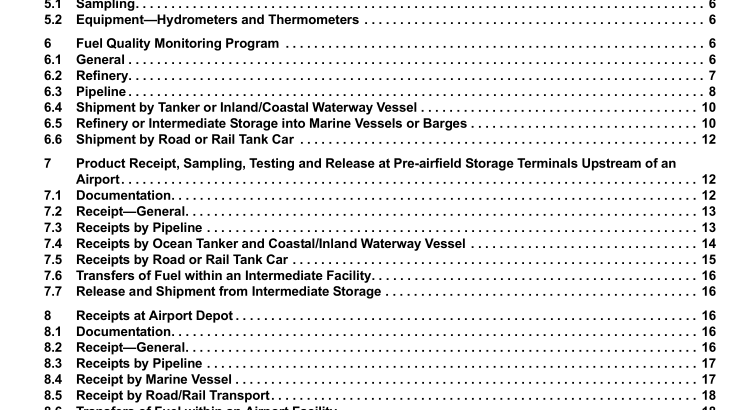API RP 1543:2009 pdf free download.Documentation, Monitoring and Laboratory Testing of Aviation Fuel During Shipment from Refinery to Airport
3.15.5 release certificate
RC This document supports any transfer of product, confirming compliance with the relevant specification(s), and contains at least the following information (see Annex C and Annex D for use by road or rail transport, and Annex E for pipeline or marine vessel) below.
a) Date and time of transfer.
b) Grade of fuel. c) Batch number and batch API Gravity at 60 °F (density at 15 °
C) of the product in the tank(s) from which it originated. If more than one batch is being included in any shipment then the quantity from each batch is required to be stated on the release document.
NOTE 15 °C is the internationally accepted temperature for conversion to standard temperature conditions, but some areas are required to use 20 °C (68 °F).
d) Confirmation that the storage tanks and filtration (where applicable) have been sumped and are free of visible water.
e) Signature of person authorized to release the product.
4 Contamination of Aviation
Fuels Aviation fuel can become contaminated during transport resulting in product that is unsuitable for use. Contamination can arise from other products and from additives [e.g. static dissipater, corrosion inhibitor, drag reducing additives (DRAs)] used in other products, which can affect fuel properties even in extremely small concentrations. Wherever contamination of this nature can occur (nondedicated transport or nonsegregated storage), recertification testing shall be performed to confirm that the fuel was delivered on specification with no significant changes to any of the properties. It is important that the results of the quality checks (see Annex A and Annex B for minimum requirements) are compared with the results from the refinery certificate of quality (RQC) or most recent certificate of analysis (COA) to determine if contamination has occurred. It is not sufficient to compare results against the specification limits alone.
Water is an ever-present contaminant in aviation fuel. Water will be present in solution (dissolved) and as “free” (undissolved) water. The higher the temperature of the fuel the more dissolved water the fuel can hold [at 60 °F (15 °C)] jet fuel can contain up to 80 parts per million (ppm) water. As the fuel temperature drops dissolved water may drop out of solution and can cause the fuel to appear cloudy. Water in solution cannot be detected by eye or chemical reaction (e.g. syringe and capsule detector or Agua-Glo® 5 ), and cannot be removed by settling or filtration. Jet fuel containing dissolved water will appear “clear and bright.”
Free water will appear as drops or as a layer on the bottom of the tank or sample container (bulk water) or as very fine droplets distributed throughout the fuel (suspended water). Bulk water and suspended water can be detected by visual examination of a sample; suspended water generally giving the fuel a hazy or milky appearance. Low concentrations of suspended water may not be detected visually [a number of methods exist for the detection of suspended water at low concentrations in Jet Fuel (e.g. the Velcon Hydrokit® 5 , Shell Water Detector® 5 and the Gammon Aqua-Glo® 5 ) (ASTM D3420)].
“Solid matter” or “particulate” is another common contaminant in fuel. Particulates usually enter the fuel as airborne dust or rust and scale from pipelines and tanks. Other possible sources of particulates include clay from ruptured filters at refineries, terminals or airports and refinery chemicals such as catalyst fines or salt from dehydrators. Particulates can normally be detected in a sample by eye, especially if the sample is swirled to create a vortex, concentrating any contaminant in the center. Membrane filtration (millipore) is often used to detect particulates and obtain a quantitative measure of the contamination in jet fuel.
5 Field Sampling and Equipment
5.1 Sampling Personnel shall undertake sampling using clearly defined procedures and appropriate apparatus to ensure that the sample obtained is truly representative of the material from which it has been drawn. The failure to carry out sampling correctly could lead to off specification product being cleared for aviation use, or result in delay and additional costs due to repeat sampling and testing. Sampling shall be in accordance with the latest requirements of API MPMS Ch. 8, ASTM D4057, and ASTM D4306.API RP 1543 pdf download.API RP 1543:2009 pdf free download
